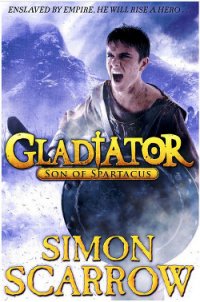Empire - Saylor Steven (читать полные книги онлайн бесплатно TXT) 📗
When Trajan returned to Roma, he celebrated with an unprecedented 123 days of games at the Flavian Amphitheatre and at other sites across the city. Ten thousand gladiators fought. Eleven thousand animals were slaughtered. The scale of these spectacles had never been seen before; nor had the scale of his lavish building programme, the results of which were to be seen in all directions from the uppermost tier of the scaffolding around the column. Apollodorus and Marcus gazed down at the largest basilica ever built, a vast hall revetted with marble and flooded with light. An adjoining courtyard, the largest open space in the city center, was dominated by an enormous statue of Trajan on horseback. Farther away, against the cliff face of the excavated Quirinal Hill, a sprawling, multistory shopping arcade was being built. There was also a gymnasium for sporting competitions and a new bathing complex even grander than the one Titus had built. On either side of the column, directly below them, were the two wings of Trajan’s library. The wing for Latin literature was almost finished, and the extravagantly decorated reading room, lined with busts of famous authors, would soon open to the public; the Greek wing was still under construction. Apollodorus, who had served as chief architect and designer of these new constructions, called them “the fruits of Dacia.”
As grand as they were, none of these buildings approached the height of the column. From the topmost scaffold, Apollodorus and Marcus stepped onto the top of the column. Their view of the city in all directions was virtually unimpeded; only the Temple of Jupiter atop the Capitoline loomed higher. Turning slowly, Marcus saw his father’s house and the sprawling House of the People on the Palatine, the Flavian Amphitheatre and the towering statue of Sol at the far end of the Forum, the cluttered tenements of the Subura, the Hill of Gardens, and the vast expanse of the Field of Mars with the bend of the Tiber beyond.
The only man-made object that reached to their level was an enormous crane situated just beyond the Greek wing of the library. Apollodorus pointed to it with a satisfied nod.
“I reworked the last of the calculations last night. Everything is ready. We’ll lift the statue into place today.”
Marcus gazed down at the workmen who surrounded the statue of Trajan that was to be placed atop the column. The men were securing the statue with padded chains and ropes connected to the crane. “How soon?”
“As soon as I can get all the workmen in place. Here, we’ll go down using the stairway inside the column. You can observe as I give my final instructions. Come along, Pygmalion.”
Long ago, from the emperor himself, Apollodorus had learned that Pygmalion had once been Marcus’s name. To Marcus, the name was a reminder of his years as a slave, but when Apollodorus first used it as a pet name for him, he had been too intimidated to object. Apollodorus clearly intended no malice; he seemed to think that the name was a compliment, an acknowledgement of Marcus’s skill as a sculptor.
As they descended, Marcus counted each of the 185 steps. He always did this. All the artisans and workmen practised similar rituals – always tying an odd number of knots, or using an even number of nails, or stepping onto a scaffold with their right foot first.
They walked to the crane and stood before the gilded bronze statue of Trajan. Apollodorus had executed the basic design, but Marcus had sculpted most of the finer details, including Trajan’s face and hands. This had meant spending long stretches of time with the emperor, who listened to reports and dictated correspondence while Marcus observed him and sculpted his likeness, first making preliminary models and then working on the full-scale statue. Marcus vividly remembered his first meeting with Trajan thirteen years ago, when his father had petitioned the emperor to recognize Marcus’s status as a freeborn citizen. Trajan had seemed larger than life to Marcus then, and he still did.
Far more accessible was the emperor’s protege, Hadrian, who had often been present when Marcus was sculpting Trajan’s likeness; perhaps Marcus found the man more approachable because he was closer to Marcus’s own age. Hadrian had distinguished himself in the Dacian wars, commanding the First Legion Minerva, but he also had an avid interest in all things artistic and had strong opinions about everything from the poetry of Pindar (“incomparably beautiful”) to Trajan’s collection of silver Dacian drinking cups (“unspeakably hideous; they should be melted down”). He was known even to dabble in architecture, though none of his fanciful drawings had ever resulted in an actual building.
Hadrian joined them as Apollodorus and Marcus were making a final inspection to see that the statue was securely fitted for lifting.
“Is the operation on schedule?” asked Hadrian.
“We’ll begin at any moment,” said Apollodorus. “Will the emperor be present?”
“He intended to be here, but affairs of state preclude his presence,” said Hadrian. He cracked a smile and lowered his voice. “Actually, I suspect he’s a bit unnerved by the whole thing. I don’t think he fancies the idea of seeing himself being hoisted a hundred feet in the air and dangling from a chain.”
“Perhaps it’s better that he’s not here,” said Apollodorus. “His presence might make the men nervous.”
Hadrian slowly circled the statue, then nodded. “What a clever idea you came up with, Marcus Pinarius, to slightly exaggerate and elongate the emperor’s features, so as to make them appear more natural when viewed by spectators on the ground. What’s the word for that?”
“It’s a trick of perspective called foreshortening,” said Marcus. “I’m grateful that you supported my idea.”
“Let’s hope it works. Caesar was certainly skeptical when he saw the result. Horrified, actually. ‘No man’s nose is that long, not even mine!’ he said. It does look a bit of a caricature when seen this close. But at a distance of a hundred feet and from a low angle, I suspect that nose will actually flatter him.”
The workmen assigned to stand atop the column and guide the placement of the statue were in place; they called and waved to Apollodorus to signal their readiness. The workmen who would operate the various hoists and pulleys of the crane were also at their stations, as were the slaves who would supply the labour to pull the ropes, turn the winches, and steady the counterweights. The statue was ready to be lifted. Apollodorus closed his eyes and muttered a prayer. Marcus touched the fascinum at his breast.
Apollodorus gave the signal for the operation to begin. With a great groaning noise, the various parts of the crane began to move. The statue cleared the ground and began to ascend.
The statue rose to half the height of the column, and then higher still, until it dangled above the column. Apollodorus peered at all the various mechanisms in play, and suddenly seemed nervous. “Marcus, run up to the top of the column,” he said. “See that everything is done correctly.”
Marcus ran to the column, stepped inside, and bounded up the steps. He was so intent on reaching the top that he forgot to count them.
The workmen atop the column stood in a circle, ready to guide the statue into the spot intended for it, the outline of which had been drawn with chalk. Each of the men wore a rope around his waist that was secured to an iron pin driven into the marble, to catch them should they fall. Marcus was not wearing a rope.
The statue seemed to float on the air nearby, twisting slightly so that the gilding reflected sparkles of sunlight. Then it began slowly to move towards them, until it appeared just above their heads. The men reached up and touched the base of the statue, which then began very slowly to descend. Their foreman shouted instructions, making sure the orientation of the statue remained true as it was lowered into place. Marcus stayed out of the way, crouching to keep his balance.


